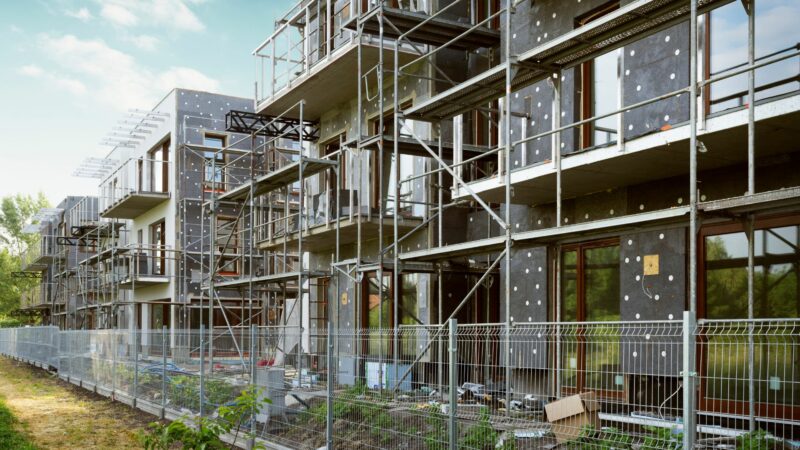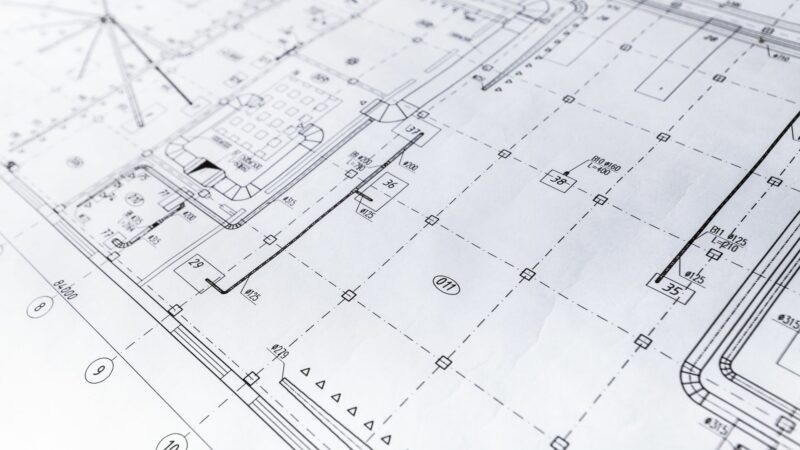The shift from office to home has many property owners eyeing their commercial spaces for residential conversion. The complexity of such a transformation can be daunting, involving an array of regulatory and practical challenges.
This article dives into the hurdles you might face and strategies to smoothly navigate this tricky terrain. Keep reading for key insights that clear the path ahead.
Key Takeaways
- Navigating zoning and building regulations is essential when turning commercial office spaces into homes. These laws dictate possible uses for the property, and changing a space from business to residential requires approval from local authorities.
- Converting office layouts to residential living involves overcoming structural limitations such as load-bearing walls, inadequate sunlight, and poor airflow. Privacy concerns and soundproofing between units also need attention.
- Costs related to conversions include hiring professionals like architects and contractors, securing permits, adapting structures for safety standards, installing new amenities, and ensuring accessibility needs are met.
- Teamwork with experienced contractors and designers can turn conversion challenges into opportunities by creatively using space to create multi-functional areas while adhering to codes.
- The process of repurposing underused commercial properties supports urban redevelopment by providing affordable housing options and revitalizing city centers.
Potential Challenges of Converting Commercial Office Space to Residential
Transforming commercial office space into welcoming residential units presents a unique set of hurdles. These trials span from navigating the intricacies of land use policies to surmounting the inherent physical constraints posed by pre-existing structures, each demanding a thoughtful approach to ensure a smooth conversion process.
Zoning and building code regulations
Zoning and building code regulations are the legal frameworks that dictate how you can use your property. Before turning commercial office space into residential units, it’s crucial to understand these rules thoroughly.
Zoning laws determine what activities can happen in which locations; therefore, changing the use of a building from commercial to housing may require approval from local authorities.
This could involve presenting your plans at zoning hearings and adapting them to fit within community guidelines.
Building codes, on the other hand, set out safety standards for construction and renovation work. They ensure that any living spaces created meet requirements for things like fire safety, structural integrity, and accessibility.
These codes might mandate significant changes to an existing structure—such as adding emergency exits or installing proper ventilation systems—which can add time and cost to your project.
Compliance with both zoning laws and building codes is non-negotiable; securing permits ensures that your converted residential units are safe and lawful places for people to call home.
Structural and design limitations
Transforming commercial office space into a cozy home is more than just moving in furniture and painting the walls. These buildings weren’t made for living, which means you’re likely to hit some structural roadblocks.
You’ve got things like load-bearing walls that can’t be moved or floor-to-ceiling heights that don’t meet residential requirements. To make a space where people feel at home, these limitations must be tackled head-on.
Design issues also pop up when flipping an office layout into apartment-style living. You have to think about how sunlight gets in and how fresh air will circulate—things offices may not have considered important.
And then there’s privacy; nobody wants to live in a place where you can hear every word your neighbor says or see inside their apartment the moment you step out of yours. Crafting quiet, private areas takes smart design solutions and sometimes even major architectural changes like adding soundproofing between units.
Accessibility and parking issues
Addressing accessibility and parking issues is crucial when converting commercial office space into residential units. Modification may be necessary to ensure building entrances, common areas, and individual unit layouts are accessible for all future residents.
Solutions like reconfiguring existing parking areas or incorporating new structures can prove indispensable in meeting the diverse needs of inhabitants.
Commercial property owners must navigate regulatory approvals that focus on the adequacy of provided facilities. Shared parking arrangements offer a creative solution where traditional options might fall short.
Overcoming these challenges not only boosts property value but also contributes to the creation of inclusive living spaces within urban centers.
– Cost and financial considerations
Cost and financial considerations
Transitioning from the logistical hurdles of accessibility and parking, cost and financial considerations take center stage in the conversion of commercial office space to residential properties.
Property managers must navigate a complex landscape of expenses that range from acquiring permits to undertaking renovations tailored for living spaces. Planning such a project demands careful assessment of potential costs against anticipated returns on investment.
Detailing these expenditures, one must account for hiring experienced architects who can turn former offices into inviting homes, contractors ready to tackle both minor updates and major overhauls, and designers who ensure new residences meet market expectations.
The cost doesn’t stop there; installing modern amenities expected in today’s apartments or condos adds another layer to your budget. These elements come together as crucial pieces in realizing the vision of transforming work environments into welcoming abodes while maintaining a tight grip on financial feasibility and sustainability.
Strategies to Mitigate Challenges of Commercial Office Space Conversion

Exploring effective strategies to mitigate conversion challenges arms commercial property owners with the knowledge to smoothly transition their spaces from office use to residential living, ensuring a profitable and sustainable transformation.
Keep reading for comprehensive solutions tailored to your project’s success.
Research and understanding of local regulations
Understanding the local regulations is a must-do step in the journey of transforming commercial office spaces into residential havens. These rules aren’t just fine print; they’re the blueprint for your project’s success or failure.
Diving deep into zoning laws, building codes, and permits will keep you from hitting costly roadblocks down the line. You’ll need to be aware of what’s allowed in terms of design, construction, and use of space.
Partnering with local authorities can provide invaluable insights and guide you through the maze of paperwork. Maintaining open communication channels ensures that you navigate through compliance smoothly without setbacks that could derail your timeline or budget.
Be proactive: learn every detail about permissible renovations, required safety features, and occupancy standards tailored to residential dwellings to make sure your conversion meets all necessary criteria for a safe and legal living environment.
Collaborating with experienced contractors and designers
Gaining a thorough knowledge of local regulations, it’s equally important to team up with skilled contractors and designers. These professionals bring a wealth of valuable experience, crucial for navigating the multifaceted process involved in transforming commercial office spaces into residential havens.
They are adept at addressing the myriad details that can make or break your project—from ensuring compliance with building codes and zoning laws to devising optimal layout plans that maximize both space and aesthetic appeal.
Contractors and designers specialize in turning challenges into creative solutions. For instance, they might repurpose an open-plan office into individual apartments while keeping the integrity of the original structure intact.
Their expertise helps ensure your converted units not only meet safety standards but also provide quality living experiences for future residents. By leveraging their seasoned perspectives, you optimize economic gains and contribute meaningfully to housing availability, all while breathing new life into urban neighborhoods.
Creative use of space and layout planning

Working hand in hand with skilled contractors and designers sets the stage for the next crucial step: reimagining your commercial office space with a fresh, residential perspective.
Layout planning is key to making every square inch count. Open floor plans can be divided into multi-functional areas using movable walls or furniture that doubles as storage units.
This strategy turns a single-use room into a living space by day and bedroom by night, optimizing functionality without compromising on style.
Eco-friendly design elements also play an integral role; they not only promote sustainability but ensure that new residential spaces meet both environmental standards and the expectations of future residents.
Creative placement of windows maximizes natural light, reducing reliance on artificial sources and creating warm, inviting homes that people love to live in. Every decision from window placement to communal spaces impacts how comfortable these converted spaces will feel as long-term homes, making creative use of space essential in this transformative process.
Budgeting and financial planning
Budgeting and financial planning are crucial steps for transforming commercial office space into residential units. Property owners need to ensure that every dollar spent contributes to the successful completion of the project while considering long-term profitability.
Costs can quickly spiral without a detailed budget, which should include renovation expenses, property tax adjustments, and insurance considerations. Financial planning isn’t just about covering immediate costs; it’s also about exploring financing options like securing loans or engaging with investors who see the value in your vision.
As you map out your finances, consider how each decision impacts your bottom line. Renovations must not only meet building codes but also attract future residents—your return on investment hinges on this balance.
It’s wise to set aside funds for unexpected expenditures that often arise during construction projects. By doing so, you keep the process moving smoothly and avoid costly delays. With a solid financial strategy in place, converting commercial spaces into welcoming homes becomes an attainable goal rather than an overwhelming task.
Moving beyond budgets and blueprints, let’s delve into enhancing those newly transformed spaces—the benefits of converting commercial office space to residential living await exploration.
Benefits of Converting Commercial Office Space to Residential
Turning commercial office spaces into residential units isn’t just about transforming buildings; it’s a strategic move towards sustainable urban development. This conversion process harnesses the potential of underused properties, offering more than just living quarters by breathing new life into city landscapes and giving rise to dynamic communities where work-life balance can truly thrive.
Utilization of existing structures
Utilizing existing structures for the conversion of commercial office spaces into residential units is a smart move that tackles two issues at once. It breathes new life into buildings that might otherwise sit empty, especially in prime urban locations where housing demand often outstrips supply.
This strategy not only meets the growing need for homes but also promotes more sustainable land use by maximizing resources already in place.
Property owners looking to convert their commercial spaces can capitalize on these advantages. Repurposing an existing structure cuts down on the environmental impact associated with demolition and new construction.
It’s a win-win scenario – preserving architectural heritage while making strides towards efficient urban redevelopment and providing much-needed housing solutions.
Increasing availability of affordable housing
Transforming commercial office space into residential units stands as a critical strategy to address the pressing need for affordable housing in our cities. This approach makes practical use of existing buildings and can bring lower-cost options to the market, meeting the demand from people who seek comfortable living spaces without breaking the bank.
Repurposing these structures often leads to reduced construction expenses compared with new builds, allowing savings to be passed on in terms of more affordable rents or purchase prices.
For you as a commercial property owner, this could signal an opportunity unlike any other: tapping into a burgeoning market while contributing positively to your community’s growth and stability.
Bringing residential life into previously business-oriented areas can rejuvenate neighborhoods and attract a vibrant mix of services and retail businesses due to increased foot traffic and local spending power.
With careful planning and execution, converting office spaces into homes not only meets a societal need but also promises economic rewards by enhancing property values around these newly converted residential hubs.
Revitalization of urban areas
Revitalizing urban areas becomes a tangible reality as commercial property owners take on the challenge of converting office spaces into residential units. This shift not only injects new life into city centers but also helps to address housing shortages, fostering a vibrant and diverse community.
Residents moving into these newly developed areas can spur economic growth by attracting local businesses and services geared towards their needs. Moreover, such transformations often enhance property values in the surrounding neighborhoods, benefiting stakeholders across the community.
The shift from commercial to residential use brings with it an opportunity for innovation in design and sustainability practices within urban development. By reimagining underused office buildings as homes, cities adapt quickly to changing demographics and keep pace with evolving housing demands.
This strategic approach sets the stage for discussing detailed strategies that can mitigate potential challenges during these conversions.
Conclusion
Tackling the complexities of turning office spaces into homes requires a solid plan and flexible thinking. Every property owner must navigate zoning laws, adhere to building codes, and carefully budget for costs.
Experts in design and construction can transform these challenges into stylish, functional living spaces. This transformation not only maximizes underused properties but also contributes to the creation of affordable housing options.
Embrace the potential for urban renewal through this innovative approach towards property conversion. Let your vision for vibrant residential communities take shape with each successful project.
Find Reliable Contractors Using BidSource
Property managers can use BidSource to have our team find a contractor ready to assist with your property type conversion needs. Share your job details using the form below and our team will be in touch with a qualified contractor!
FAQs
1. What are the main challenges in converting commercial office space to residential units?
Key challenges include rezoning, meeting residential building codes, and adapting existing structures for living spaces.
2. Can the commercial infrastructure of an office building support residential needs?
The infrastructure may need significant updates to accommodate residential requirements like plumbing, electrical systems, and ventilation.
3. How does converting a commercial office space impact the neighborhood?
Converting commercial space can change the local dynamics by introducing more residents and altering traffic patterns.
4. Is it cost-effective to transform commercial office space into apartments or homes?
The cost-effectiveness depends on factors such as renovation expenses versus potential rental income or property value increases.
5. Are there legal considerations when changing a property from commercial to residential use?
Yes, legal concerns include obtaining permits, adhering to zoning laws, and ensuring compliance with housing regulations.


